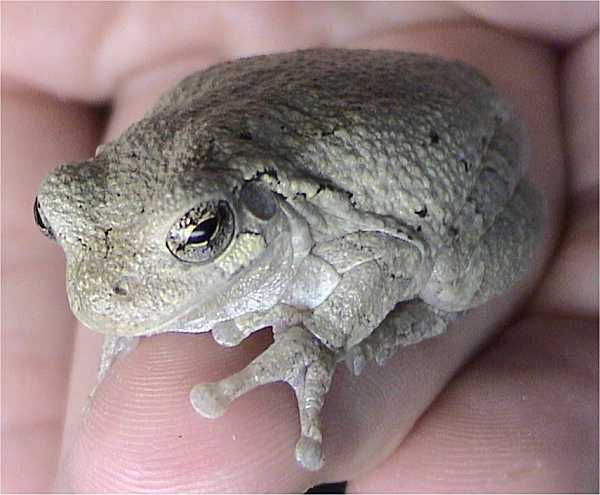|
| Query: Grey squirrel | Result: 172nd of 288 | |
Gray Tree Frog (Hyla versicolor) - Wiki
| Subject: | Gray Tree Frog (Hyla versicolor) - Wiki
| |

| Resolution: 600x495
File Size: 30946 Bytes
Upload Date: 2007:10:08 17:21:56
|
Gray tree frog
From Wikipedia, the free encyclopedia
[Photo] Photographer: LA Dawson (http://en.wikipedia.org/wiki/User:Dawson). Grey Tree Frog, Hyla versicolor
The Gray tree frog (Hyla versicolor) is a species of small arboreal frog native to much of the United States and into Canada. It is sometimes referred to as the North American common tree frog.
Physical description
Gray tree frogs are, as their common name implies, predominately gray in color. They can be light or dark gray, or light gray with darker gray, black, yellow or green mottling. They are relatively small compared to other North American frog species, typically attaining no more than 1.5 to 2 inches (4cm to 5cm) in length. Their skin has a lumpy texture to it, giving them a warty appearance. They are virtually indistinguishable from the Cope's Gray Tree Frog, Hyla chrysoscelis, the only readily noticeable difference being their call.
Both Hyla chrysoscelis and Hyla versicolor have bright orange patches on the hind legs, which distinguishes them from other tree frogs, such as Hyla avivoca (Martof et al. 1980). Both species of Gray tree frogs are slightly sexually dimorphic. Males have black or gray throats, while the throat of the female is lighter (Tyning 1990).
Tadpoles have a rounded body (as opposed to the more elongated bodies of stream species) with a high, wide tail that can be colored red if predators are in the system. Metamorphosis can occur in as little as 2 months with optimal conditions. At metamorphosis, the new froglets will almost always turn green for a day or two before changing to the more common gray.
Geographic range
Gray tree frogs inhabit a wide range, and can be found in most of the eastern half of the United States, as far west as central Texas. They also range into Canada in the provinces of Ontario and Manitoba, with an isolated population in New Brunswick.
Behavior
Gray tree frogs are primarily arboreal, spending time in wooded areas, usually not far from a permanent water source. On rainy evenings they can often be found calling in or near shallow, temporary pools of water. They are nocturnal and insectivorous, consuming most any small arthropod they can catch. Mating occurs throughout the spring and summer months.They also will change colors, as in a light green to a gray, to match their habitat.
In captivity
Wild caught gray treefrogs are frequently found in the pet trade. They make excellent, undemanding captives. A moderately humid vivarium of live plants is generally quite adequate to house them, along with a varied diet of commercially available crickets, small moths and other insects. Be sure to provide a source of water for your tree frog or mist frequently to keep the skin moist.
Conservation
There are several environmental changes that affect Hyla versicolor, including ones that result from human land use and development. Studies indicate that Hyla versicolor is moderately tolerant of pH levels as low as 3.5. UV-B radiation does not affect egg and larvae survival, but does reduce swimming activity. 200 ??? Concetrations of 2,000 micrograms per liter of Atrazine, a globally used herbicide used against pre- and post-emergence broadleaf and grassy weeds in major crops, gave tadpoles 10% less body mass and were 5% shorter than normal water concentrations. The larval period also took 5% longer in the greater concentration. Carbaryl, also known as Sevis, is the third-most-used insecticide. By itself, it does not hurt things, but UV-B radiation photoenhances its toxicity, reducing swimming activity and killing 10% - 60% of the tadpoles exposed to weak concentrations of this chemical for long periods of time. If predatory cues were also present, it killed an even greater 60% - 98% of the tadpoles.
http://en.wikipedia.org/wiki/Gray_tree_frog
| The text in this page is based on the copyrighted Wikipedia article shown in above URL. It is used under the GNU Free Documentation License. You may redistribute it, verbatim or modified, providing that you comply with the terms of the GFDL. |
|
Comments |
|---|
| | Josh L. |
|
| I love reading about eastern gray tree frogs. i own a wild one i found on a squirrel corn feeder here in indiana on may 4th, 2009. i feel as if i bond with my treefrog. but if they turn green does that mean they are happy? if not then how can u tell if they are happy or not? |
^o^
Animal Pictures Archive for smart phones
^o^
|
|
|